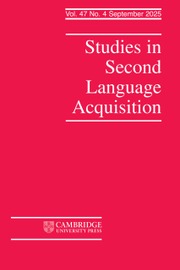MORPHOLOGY AND LONGER DISTANCE DEPENDENCIES
LaboratoryResearch Illuminating the A in SLA
Published online by Cambridge University Press: 01 June 1997
Abstract
This paper illustrates the advantages of laboratory research into SLA by describing twostudies of acquisition of second language syntax. The first addresses the question of whetherhuman morphological abilities can be understood in terms of associative processes or whether itis necessary to postulate rule-based symbol processing systems underlying these skills. Wedemonstrate that acquisition of L2 morphology shows frequency effects for both regular andirregular forms and that the acquisition course of learners' accuracy and reaction time canbe accurately simulated by connectionist systems. The second concerns a bootstrapping accountof SLA whereby processes of chunking in phonological memory underpin the acquisition oflong-term memory for utterances and abstractions of grammatical regularities. It shows thatphonological short-term memory is particularly important in the acquisition of long-distancedependencies. In both cases, it is argued that these aspects of SLA reflect associative learningprocesses. When SLA research is properly focused on acquisition, laboratory research allowsinvestigation of the learners' exposure to evidence, their processes of perception andlearning, and their resultant language representations.
Information
- Type
- Research Article
- Information
- Copyright
- © 1997 Cambridge University Press
Footnotes
- 55
- Cited by

